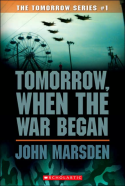The following discussion contains spoilers.
 MICHELLE: As we did for the CLAMP Manga Moveable Feast, special guest Karen Peck and I decided to collaborate on a contribution. This month’s MMF theme is vampires, so we opted (actually, this was totally Karen’s brainwave) to talk about Canon, the four-volume Chika Shiomi shoujo series published by CMX. I really didn’t know what to expect, having never read it before, but I think you had, right, Karen?
MICHELLE: As we did for the CLAMP Manga Moveable Feast, special guest Karen Peck and I decided to collaborate on a contribution. This month’s MMF theme is vampires, so we opted (actually, this was totally Karen’s brainwave) to talk about Canon, the four-volume Chika Shiomi shoujo series published by CMX. I really didn’t know what to expect, having never read it before, but I think you had, right, Karen?
KAREN: I read it years ago, as I am a total Chika Shiomi fangirl, and figured the MMF would be a great excuse to talk about a lesser-known CMX series. A little background on Chika Shiomi and the series—Canon was her first series after her 1993 debut, running in Mystery Bonita Special. She’s one of those mangaka who’s had her work released by several English-language publishers—Night of the Beasts by Go!Comi, one volume of Queen of Ragtonia by Aurora, and Viz has most recently released Yurara and its sequel series Rasetsu. Her current work is Yukarism, a time-travel tale running in Bessatsu Hama to Yume, which is currently on hiatus.
Canon Himuro, ill with an incurable disease, was the sole survivor of a massacre that left her classmates dead. Months later a reporter runs into her, and she looks healthier than before—and carries a secret. Her classmates were attacked by a vampire, who then turned Canon into one. Horrified and wracked by guilt, she declares revenge on the vampire with silver hair and blue eyes. Holding onto her humanity, Canon refuses to drink blood, and wears a cross necklace given to her by a kindly foreigner, as explained in the second chapter. She is also accompanied by a vampire crow, Fui, who helps keep the story going and provides the humor. Canon is out for vengeance; Fui would just like a snack.
So, Michelle, what did you think of the series? Beyond the ’90s fashion, that is?
MICHELLE: I shall tell you, though we really must get back around to the fashion topic!
I ended up enjoying Canon quite a lot, though moreso in the first two volumes. The story begins episodically, and after a first volume that I’d describe as “not riveting, but entertaining,” the second volume packs a real wallop as Rod (such an intimidating name!)—the silver-haired, blue-eyed vampire—makes his entrance. By this point, Canon has met Sakaki, a smug and violent half-breed who’s also out for revenge against Rod (who murdered his parents), and they’ve formed an alliance. Fairly soon, though, Rod’s servants are telling Canon that their master lives as a hermit and couldn’t possibly be responsible for the attack upon her classmates, and suggesting that the real culprit is Sakaki. Canon resists the truth until Fui overhears a conversation confirming it (and is gravely wounded by Sakaki as a result).
I probably should’ve seen this reveal coming, but I was sort of enjoying the series in an uncomplicated way and wasn’t expecting it to veer into territory this dark. Ultimately, you’ve got Canon unable to forgive Sakaki, Sakaki unable to forgive Rod, and some uncomfortable parallels for Canon to navigate as her own hatred (fueled by the humiliation of having been tricked) threatens to undo her efforts to retain her human heart. It’s good stuff, really!
That said, I thought the entrance of Glenn as a common enemy kind of squandered the momentum a little. I mean, I’m glad that Rod and his awesome servant, Machua, got to become good guys, but Glenn lacks any real depth as a character, and I found his sudden change of heart regarding Canon—he’d previously been adamant about the need to exterminate her—rather baffling.
KAREN: The names crack me up, too. “Rod” just doesn’t sound… menacing. Rod and Glenn sound like they’d be assistant managers at an Office Depot, not powerful vampires.
It is good stuff! One thing I dislike about vampire stories—in manga and in print—is the angsty, boohoo I’m a vampire aspect. Canon does not wallow in that too much, the action is swirling around her and she’s a part of it all—she’s not a passive character. I think the shortness of this series helped as well; she had to stick to the unexpectedly twisty story–everyone has a motive, and they’re bound by vampire laws and revenge. Except Glenn. I agree with you, Michelle, that his change of heart is baffling–he’s the person that exists to move the story in one direction yet doesn’t seem to be upset that his purpose in the story is nullified by that direction. It’s a bit sloppy, but given how well she plotted out everything else, I’ll give Shiomi-sensei a pass since this is her first work.
As for the Canon/Sakaki relationship, at first I didn’t get it. After some consideration, though, it does fit in with what Canon was trying to get through to Sakaki and Rod–to stop the cycle of vengeance, that everyone can move on. Yes, Sakaki created Canon and messed with her memories to create a weapon to get at Rod in an exquisitely personal way, but her own words apply just as much to herself. She could kill him for her own vendetta, or she could remember that little boy who was left bleeding next to the corpses of his parents and understand what drove him. There’s a theme of forgiveness and breaking cycles here that I think is (mostly) well-done.
So, back to the fashion. Canon’s ankle boots have actually come back around to being fashionable again, but I fear that Rod’s overcoat on top of a turtleneck overcoat look will never be repeated. I suppose hermit vampires who feel bad about killing their best friends are just naturally chilly?
MICHELLE: I hadn’t actually seen that about Rod’s garb until you pointed it out, but once I did, I couldn’t stop noticing it. I think I thought the black one was a cloak at first, but upon closer inspection, it clearly has sleeves.
You’re absolutely spot-on about Canon remembering the terrible things that had happened to Sakaki that caused him to inflict terrible things upon her. And though it might feel like a betrayal of her classmates, she can’t stop loving him. This reminded me a lot of Shuri and Sarasa in Basara, actually, where she is able to forgive him for the atrocities committed as the Red King, even though other villagers will never be able to. And, of course, any time something can be compared to Basara is a good sign!
Speaking of comparisons to other works, the side story in volume four about the other half-breed who briefly takes care of orphaned Sakaki reminded me a lot of Shion’s backstory in Please Save My Earth, as another example of a boy in such tremendous need who tragically loses yet another person who could’ve shown him love. And Sakaki’s physical appearance reminds me some of Tokyo Babylon‘s Seishirou, especially round about the shoulder region.
Actually, Sakaki’s got some fashion challenges of his own to surmount. In this picture, his coat’s billowing so much it looks like a frickin’ hoop skirt!
KAREN: I know–why does he need two coats? I think it’s a little hypocritical of a vampire to wear turtlenecks anyway.
Now you’re reminding me that I need to finish reading Basara! But it’s a good comparison, and one that reflects favorably on Chika Shiomi–I think a lot of people can write a love story, but it’s harder to write one where it makes sense and is right for the characters. Hand-waving with a “that’s how love is!” is lazy, and she doesn’t take the easy way out. The ending offers a further complication, but again, it goes with the feeling that the characters really need to want this instead of just engaging in relationship fanservice.
The art—especially for Sakaki—really had a CLAMP-circa-X vibe going on, but this was 1994. I also enjoyed Machua’s style, even if it wasn’t as flamboyant and flowing.
MICHELLE: I liked her, too, though at first I thought she might be a dude!
The art really is frequently lovely in that early-’90s kind of way. Below I’ve included an image of one of my favorite two-page spreads, where you’ve got all sorts of overlapping panels, huge flowers, leads superimposed over a background of space… My cynical side wonders if Shiomi had a checklist of specific items to include, but the overall effect is still one I enjoy. And, of course, I can’t help thinking that MJ, with her well-documented love for old-school shoujo art, would just love this to pieces. (Click image to enlarge.)
KAREN: This is some lovely ’90s art, and it holds up pretty well—Canon herself (sans ankleboots) could just as easily be a design in a modern Chika Shiomi work. I also enjoyed her eye for action–I was a little unsure about how the vampires were always leaping about, but I assume it’s a case of Our Vampires Are Different. The pages you picked show how nice a page with flashbacks and conversations can be–it’s not just good storytelling, it also sets an emotional mood that really sells the scene for me.
I’m glad there was a Vampire MMF to make me get this series off the shelf and re-read it. It’s one of those quiet CMX series that came and went with little fanfare, but shows how well-curated their shoujo line was–I’m sure they could have found a more sensationalistic vampire manga with prettier, broodier boys, but this is one with an overall strong story and a tough heroine. It may not be a classic on the lines of contemporary works like X, but it’s cheap on the used market and, in my opinion, a good short series.
MICHELLE: I definitely agree! Thank you for suggesting it!
And now, an announcement: because Karen and I had such a good time reading Canon, it really fanned the flames of “Damn, we miss CMX.” And so, to help offset our still-lingering pain, we’ve decided to embark upon a monthly feature called The CMX Project, where we will revisit both the lauded and the lesser-known works from the CMX catalog. Look for the first column—featuring Land of the Blindfolded—in January 2013!


























Recent Comments